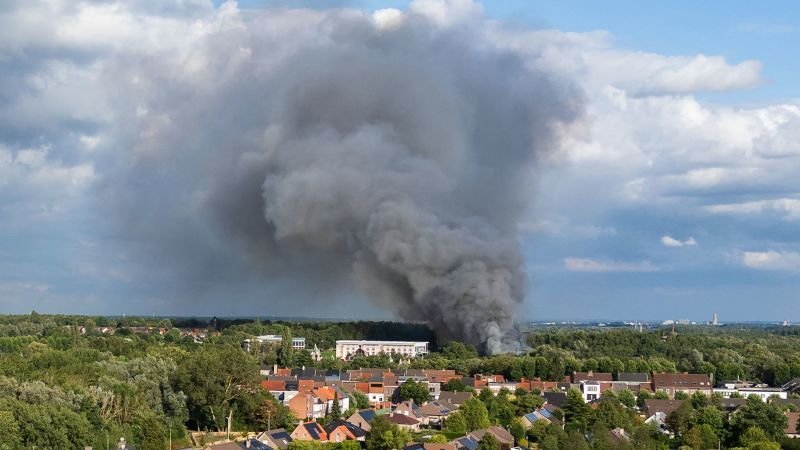CNN
—
In the small Norwegian town of Bodø, located just inside the Arctic Circle, the days can be short and the winters bitterly cold. It’s hardly the type of place you’d expect to find an elite soccer team, especially when shovels are sometimes needed to clear fresh layers of snowfall from the local pitches.
A certain kind of fortitude and tenacity is needed to withstand the howling winds and freezing temperatures which batter the town for many months of the year, but Bodø/Glimt is no ordinary team and its proud army of supporters is no ordinary fanbase.
Having recently won a fourth Norwegian league title in five years, Bodø/Glimt is now used to rubbing shoulders with Europe’s soccer elite. On Thursday, the club will travel to Tottenham Hotspur Stadium – a stadium with a capacity of 62,850, almost 10,000 more than the entire population of Bodø – to face Spurs in the first leg of their UEFA Europa League semifinal.
“Luckily for us players, we are quite used to it now. We’ve been through a lot of difficult games in big, big stadiums. So we are quite used to it, but for the city and for everyone else, I think it’s a bit shocking,” winger Jens Petter Hauge told CNN Sports ahead of the match against Tottenham.
Earlier this month, underdog Bodø/Glimt became the first Norwegian team to reach the semifinals of a European competition after besting Lazio on penalties in the return leg in Rome.
Now, the town and its fans are gearing up for Bodø’s next showdown.
“It was chaos. With the tickets for the match, we only had a few hundred to sell, and it was a lot of people trying to get the tickets. And it’s all people speak about now in the city. And if you go for a coffee or go to the shop, everyone wants to speak about this match,” Hauge added.
“It means everything for this club and the players who are here. We really want to show that we can compete on the biggest stage against the best clubs in the world,” he added.
It’s perhaps fortunate for Spurs that the second leg match in Bodø is taking place in May; in the winter months, teams visiting the Arctic Circle can face unique and unforgiving conditions.
“For us, we train in it a lot, so we’re kind of used to it compared to maybe those who come from warmer places in January,” midfielder Håkon Evjen told CNN earlier this year,
Evjen, currently in his second stint at the club, can count among his recent career highlights a wonderful, edge-of-the-area strike into the top corner to equalize against Manchester United at Old Trafford in November.
Even more remarkable than that goal was the fact that Bodø/Glimt was cheered on by more than 6,500 fans at the game, around 12% of Bodø’s 55,000 inhabitants. If ever there was a sign of how one town had become so devoted to its soccer club, then this was it.
“We have so much support and the entire town is now almost a football town,” said Evjen. “It’s beautiful to see how football can change the city and how people look at it. To play here now, it’s so much bigger than how it was a few years ago.”

Bodø/Glimt – “glimt” means “flash” and the team accordingly plays in all yellow – used to bounce between the top four divisions of Norwegian football. Success is only a recent phenomenon in the club’s 108-year history.
Under manager Kjetil Knutsen, the team has reaped the rewards of disciplined training sessions, a new, high-pressing style of play, and a clever recruitment strategy, blossoming into Norway’s most decorated side across the past five years.
Saltnes, who arrived at Bodø/Glimt more than a decade ago, said that the club now feels “worlds apart” compared to where it was when he joined. “I will almost rank it as semi-professional when I came through, whereas now it’s a top, top professional level,” he added.
When Bodø/Glimt won its first-ever league title in 2020, it did so in historic fashion, finishing a huge 19 points ahead of runner-up Molde FK and ending the campaign with a record-breaking 103 goals across 30 matches.
“It is a team, a coaching staff and a club that has changed really a lot for the better,” said Evjen, who played in the Netherlands and Denmark in between his two stints with Bodø/Glimt. “It’s really more professional and more committed to trying to be the best team in Norway.”

Thursday’s stand-off with Tottenham is just one of many challenges awaiting Bodø/Glimt, whose wider goal is to qualify for the Champions League for the first time in the club’s history.
“We’ve come so close twice to reaching the Champions League, and that would really be a bit statement,” veteran midfielder Ulrik Saltnes told CNN Sports earlier this year. “Financially, it’s a totally different league and also just for everyone in European football, it would really show that Glimt is here to play.
“It’s not like, in a couple of years, you will never hear about us again. I think reaching the Champions League would really be the next step for the club.”

The remarkable rise of Bodø/Glimt

























